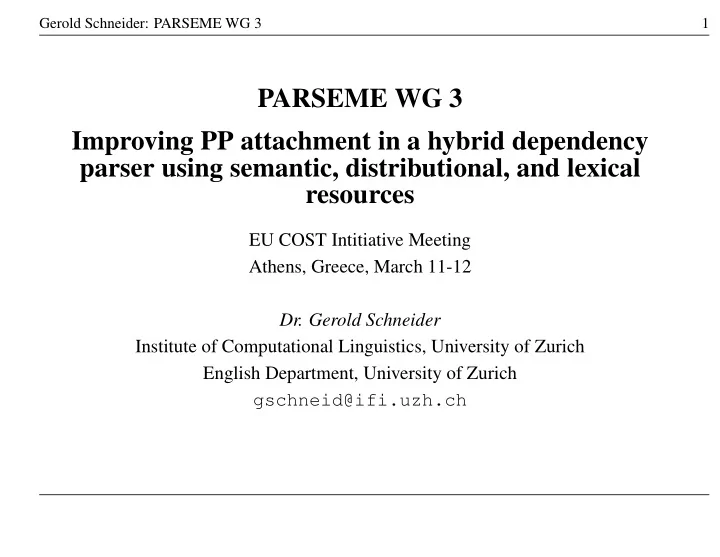

Gerold Schneider: PARSEME WG 3 1 PARSEME WG 3 Improving PP attachment in a hybrid dependency parser using semantic, distributional, and lexical resources EU COST Intitiative Meeting Athens, Greece, March 11-12 Dr. Gerold Schneider Institute of Computational Linguistics, University of Zurich English Department, University of Zurich gschneid@ifi.uzh.ch
Gerold Schneider: PARSEME WG 3 2 Q: how much do multi-word resources improve parsing? 1. Multi-Word Terminology Pro3Gres (Schneider, 2008) uses chunker pre-processing, only parses between heads. • On in-domain text (Penn, GREVAL): – with standard NER (LT-TTT2): worse, most multi-word terms are shorter than chunks • On out-of-domain (Biomedical): – with domain NER: Replace term with term head in pre-processing. Better than chunker, as it corrects many tagging errors (Weeds et al., 2007) – with domain-trained tagger: similar to slightly lower performance → statistical > lexical resources 2. Improving PP-attachment: Details in Schneider (2012) LREC Caveat: arguments vs. adjuncts (verbal and nominal): PP-arguments in Pro3Gres: 90% recall ↔ PP-adjuncts in Pro3Gres: 66% recall → are multi-word resources the right tools?
Gerold Schneider: PARSEME WG 3 3 PP attachment relations are multi-word constructions for which many resources exist, and they are highly ambiguous. Our parser uses tri-lexical disambiguation (Collins, 1999) p ( R, dist | a, b, c ) ∼ f ( R,a,b,c ) R ) ,a,b,c ) · f ( R,dist ) = p ( R | a, b, c ) · p ( dist | R ) = f (( � fR • various lexical resources , e.g. and we added these multi-word resources: verb-valency dictionaries: no • semantic expectations learnt from Penn improvement → implicit in stats TB [ p( dog hunts) > p( rabbit hunts ) ]: From BASE to COMBINED: improves • PP interactions (see DOP: Bod, Scha, and Sima’an (2003)): improves • distributional semantics to alleviate sparse data [ p ( prep 2 | v, prep 1 ) ], learnt unsupervisedly from the British National corpus (BNC), using non-negative matrix factorisation (Lee and Seung, 2001): marginal improvement • self-training , using the BNC: marginal improvement
Gerold Schneider: PARSEME WG 3 4 References Bod, Rens, Remko Scha, and Khalil Sima’an, editors. 2003. Data-Oriented Parsing . Center for the Study of Language and Information, Studies in Computational Linguistics (CSLI-SCL). Chicago University Press. Collins, Michael. 1999. Head-Driven Statistical Models for Natural Language Parsing . Ph.D. thesis, University of Pennsylvania, Philadelphia, PA. Lee, Daniel D. and H. Sebastian Seung. 2001. Algorithms for non-negative matrix factorization. Advances in Neural Information Processing Systems , pages 556–562. Schneider, Gerold. 2008. Hybrid Long-Distance Functional Dependency Parsing . Doctoral Thesis, Institute of Computational Linguistics, University of Zurich. Schneider, Gerold. 2012. Using semantic resources to improve a syntactic dependency parser. In Viktor Pekar Verginica Barbu Mititelu, Octavian Popescu, editor, SEM-II workshop at LREC 2012 . Weeds, Julie, James Dowdall, Gerold Schneider, Bill Keller, and David Weir. 2007. Using distributional similarity to organise BioMedical terminology. In Fidelia Ibekwe-SanJuan, Anne Condamines, and M. Teresa Cabr´ e Castellv´ ı, editors, Application-Driven Terminology Engineering . Benjamins, Amsterdam/Philadelphia.
Recommend
More recommend